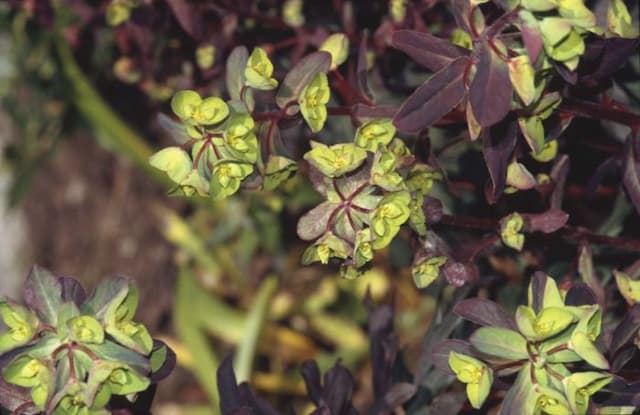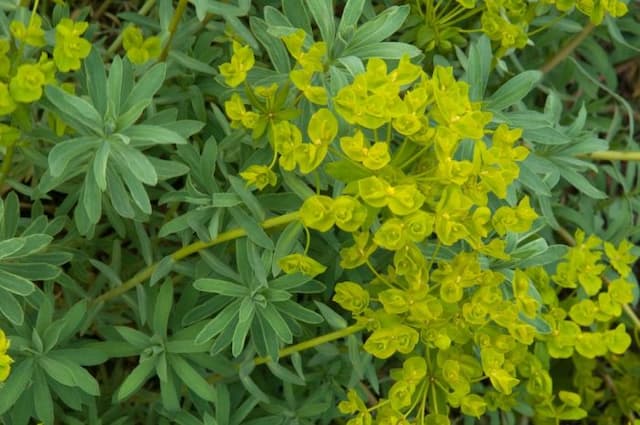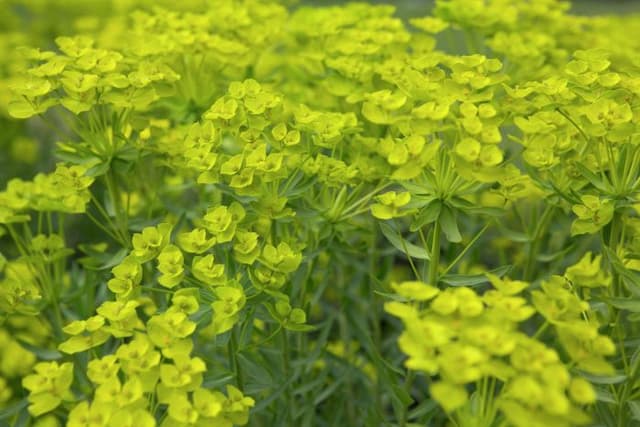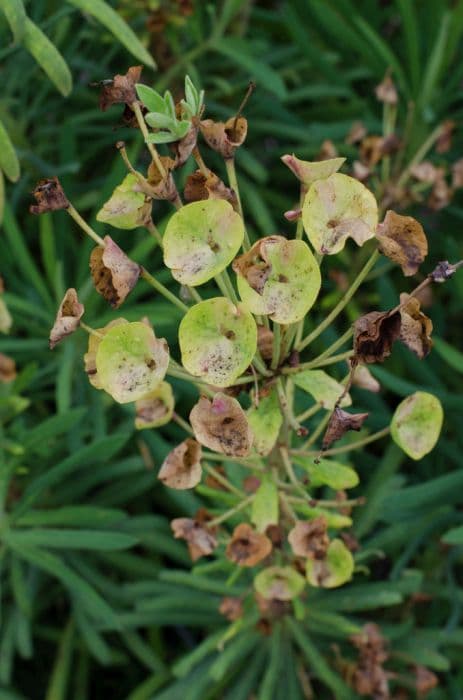Spurge 'Black Pearl' Euphorbia characias 'Black Pearl'

ABOUT
'Black Pearl' is a compact cultivar of E. characias with lime green flowers and clearly visible black nectar glands
About this plant
 Names
NamesFamily
Euphorbiaceae
Synonyms
Mediterranean Spurge, Black Pearl Spurge
Common names
Euphorbia characias 'Black Pearl'.
 Characteristics
CharacteristicsLife cycle
Perennials
Foliage type
Evergreen
Color of leaves
Blue-green
Flower color
Green
Height
3 feet [0.91 meters]
Spread
3 feet [0.91 meters]
Plant type
Shrub
Hardiness zones
8
Native area
Mediterranean
Benefits
 General Benefits
General Benefits- Ornamental Appeal: Adds visual interest to gardens with its distinctive upright stems, dark foliage, and spherical greenish-yellow flowers.
- Drought Tolerance: Once established, it is very drought-tolerant, making it an ideal plant for dry and low-water gardens.
- Low Maintenance: Requires minimal care once established and is relatively pest and disease-free, making it an excellent choice for novice gardeners.
- Long Blooming: Has a long flowering period extending from early spring to the end of summer, providing an extended display of interest in the garden.
- Deer Resistance: Rarely eaten by deer, making it suitable for gardens in areas where deer browsing is a problem.
- Erosion Control: Its root system can help stabilize soil in sloped gardens or areas prone to erosion.
- Attracts Pollinators: Flowers provide nectar and pollen for bees and other beneficial insects, supporting local ecosystems.
- Architectural Structure: Its strong vertical growth pattern adds architectural interest to garden designs.
- Adaptability: Can thrive in a variety of soil types as long as they are well-drained.
- Seasonal Interest: Provides year-round interest with its persistent structure, even when not in bloom.
 Medical Properties
Medical PropertiesThis plant is not used for medical purposes.
 Air-purifying Qualities
Air-purifying QualitiesThis plant is not specifically known for air purifying qualities.
 Other Uses
Other Uses- Dye Production: The sap of Euphorbia characias 'Black Pearl' may be used as a natural dye for fabrics, although caution must be exercised due to its irritant properties.
- Insect Repellent: This plant's milky sap has been traditionally used to deter insects and can be infused into natural repellents.
- Fish Poison: Some cultures use the toxic sap to stun or kill fish, making them easier to catch.
- Decorative Patterns: The unique shape and texture of the 'Black Pearl' can be used as inspiration for patterns in design and art.
- Tool Handle Coating: The durable nature of the wood from Euphorbia characias may be used for making handles for various tools and implements.
- Photography Subject: With its striking appearance, the 'Black Pearl' variety is a favorite subject for plant photographers and botanical artists.
- Water Conservation Education: As a drought-resistant plant, it is used to educate on water-wise gardening practices and xeriscaping.
- Mood Enhancement: The aesthetic appeal of Euphorbia characias 'Black Pearl' in gardens and landscapes can contribute to mental well-being and stress reduction.
- Livestock Deterrent: The toxicity of the sap can help keep livestock from grazing in areas where this plant is present.
- Cultural Symbols: In some cultures, the distinct form of the Euphorbia genus is used symbolically in ceremonies or artwork to represent resilience or protection.
Interesting Facts
 Feng Shui
Feng ShuiThe Mediterranean Spurge is not used in Feng Shui practice.
 Zodiac Sign Compitability
Zodiac Sign CompitabilityThe Mediterranean Spurge is not used in astrology practice.
 Plant Symbolism
Plant Symbolism- Resilience: Euphorbia, commonly known as Spurge, often symbolizes resilience as it can thrive in harsh conditions with little care.
- Protection: Spurge has a sap that can be irritating to the skin and eyes, which gives it the symbolic meaning of protection against negative forces.
- Persistence: This plant has a steadfast growth habit, representing persistence and determination in overcoming adversity.
- Cleansing: Historically, some Euphorbia species were used medicinally for cleansing the body, thus symbolizing purification and renewal.
 Water
WaterMediterranean Spurge requires moderate watering, especially during its blooming period in spring and summer. It should be watered when the top inch of soil feels dry to the touch. Generally, this means watering approximately once a week, but frequency should be adjusted according to weather conditions, with less water required during cool or rainy periods. Provide about 1 gallon of water to thoroughly soak the soil around the plant, ensuring even moisture penetration. During winter, reduce watering significantly to prevent waterlogging, as the plant is drought-tolerant and prefers drier conditions in its dormant phase.
 Light
LightMediterranean Spurge thrives in full sun to partial shade. The ideal spot for this plant is a location where it can receive at least six hours of direct sunlight daily. It can tolerate some shade, but too much shade can lead to leggy growth and fewer blooms, so areas with bright, unfiltered light are preferable.
 Temperature
TemperatureMediterranean Spurge is hardy and can handle temperatures as low as 30°F but should be protected from frost. The ideal growing temperature for the plant ranges from 50°F to 75°F. It can withstand some heat, but excessive temperatures above 86°F may stress the plant. Providing ample air circulation can help maintain optimal conditions during hotter periods.
 Pruning
PruningPruning Mediterranean Spurge is crucial to maintain shape, encourage bushy growth, and remove spent flowers to promote new blooms. The best time to prune is late winter or early spring before new growth begins. Cut back the plant by about one-third of its size to stimulate healthy development. Deadheading, or the removal of old blooms, should be done as soon as flowers fade.
 Cleaning
CleaningAs needed
 Soil
SoilMediterranean Spurge, often named Euphorbia characias 'Black Pearl', thrives best in a well-draining soil mix with plenty of grit or sand to ensure proper drainage. An ideal soil mix would consist of 2 parts loam, 1 part sand or perlite, and 1 part peat or humus. The soil pH suitable for this plant should be slightly alkaline, around 7.0 to 7.5.
 Repotting
RepottingMediterranean Spurge, or Euphorbia characias 'Black Pearl', does not require frequent repotting; every 2-3 years is sufficient. This plant prefers to be slightly root-bound, so only repot when you notice signs of the plant outgrowing its current pot or if there is significant soil degradation.
 Humidity & Misting
Humidity & MistingMediterranean Spurge, or Euphorbia characias 'Black Pearl', is well adapted to a range of humidity levels and does not require high humidity. It is quite drought-tolerant once established, and typical outdoor humidity levels are generally sufficient.
 Suitable locations
Suitable locationsIndoor
Place in bright light, minimal water.
Outdoor
Full sun to partial shade, well-drained area.
Hardiness zone
7-10 USDA
 Life cycle
Life cycleEuphorbia characias 'Black Pearl', commonly known as Mediterranean Spurge or Black Pearl Spurge, starts its life cycle with seed germination, which typically occurs in warm, moist soil conditions. Once the seedling emerges, it enters the vegetative stage, where it develops a strong, woody root system and begins to grow its characteristic foliage—long-lasting, blue-green leaves with a distinctive upright habit. Over time, the plant matures and reaches its reproductive stage, producing unique bracts and cyathia (the true flowers) that can exhibit a dark, almost black central gland, giving the 'Black Pearl' its name. After pollination, the plant sets seeds, which are then dispersed, often by wind, to initiate a new generation. The plant is perennial, and as it ages, it may begin to decline in vigor, potentially leading to a dormant or senescent phase before it completes its life cycle. Regular pruning and removal of spent flowers can encourage new growth and prolong the plant's attractive appearance and lifespan.
 Propogation
PropogationPropogation time
Spring-Early Summer
Propogation: Euphorbia characias 'Black Pearl', commonly known as the Mediterranean Spurge, is typically propagated by seed or cuttings. However, the most popular method is by taking cuttings. To propagate by cuttings, in late spring or early summer, select a healthy, non-flowering shoot and cut a 3 to 4-inch (approximately 7.5 to 10 cm) section. Strip the lower leaves from the cutting and allow the cut end to dry and form a callus for a few days. After the callus forms, insert the cutting into a well-draining soil mix, and keep it moist but not wet. Place the pot in a warm environment with indirect light. Roots should develop within a few weeks, after which the new plant can be gradually acclimated to outdoor conditions.









